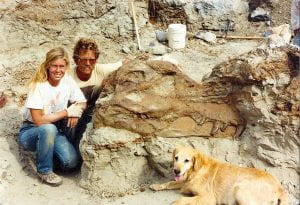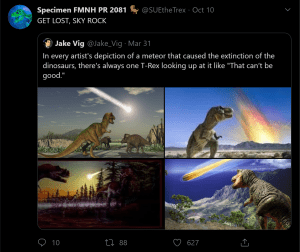A FASCINATING PIECE, CROSS POSTED FROM THE BRISTOL DINOSAUR PROJECT BLOG, WITH PERMISSION.
Guest Author – Han Kemp
2nd Year Undergraduate Student in Palaeontology, University of Bristol
Twitter is a great social media platform that’s allowed me to follow along with all kinds of palaeontologists and fossil aficionados. One such account is SUE (@SUEtheTrex), representing one of the largest and most extensive Tyrannosaurus rex specimens ever found. The 67-million-year-old enthuses over Jeff Goldblum, plays Dungeons and Dragons with their followers, and gets angry at people who mention meteors. This might sound a little confusing, so let me add some context.
Sue Hendrickson discovers FMNH PR 2081
In August 1990, Sue Hendrickson – an explorer and fossil collector – found small pieces of bone at the base of a cliff in South Dakota. She was there with other members of the Black Hills Institute of Geological Research, who confirmed the bones belonged to a T. rex and began excavating.

What they found was an incredible skeleton, with over 90% of it (by bulk) recovered – the most complete T. rex fossil ever unearthed. Since 1997 it has been a feature at the Field Museum of Natural History in Illinois as Specimen FMNH PR 2081. [1] It gained the nickname SUE (all capitals) after its finder. SUE has been an incredible resource for palaeontology, giving scientists tons of information about this dinosaur and the world it lived in, including biology, biomechanics, growth and behaviour. Its sex has not been determined, nor the actual cause of its death.
But this post is in the pop-culture section for a reason – let’s talk about social media.
SUE the T. rex gets on Twitter

Since 2009, the Field Museum has run an account representing SUE on Twitter and has gained over 50 thousand followers. The Twitter SUE is snarky, makes puns, and has formed a unique personality. SUE’s account became more popular in 2017 when they started an interactive game of Dungeons and Dragons with their followers, creating polls to let users decide what their character (a hadrosaur dino-sorcerer) would do next. Other Chicago-based institutes like the Shedd Aquarium and the Adler Planetarium also joined in the fun by becoming characters in the adventure, and garnered the game more attention. As interactions with the account became more frequent, it became a bigger issue that followers were referring to SUE as a girl, she/her, or Sue (lowercase). Due to their name, SUE was being perceived as female – but the T. rex’s sex is still up for debate and has not been determined either way. As such, letting SUE be a ‘girl dinosaur’ was scientifically very misleading. While the specimen itself is still referred to as an ‘it’, that didn’t feel like the right pronoun for SUE’s online personality. So SUE added they/them pronouns to the ‘Bio’ section of their profile, and addressed it in a tweet saying:
“– Science doesn’t know my actual sex.
– If it helps one person feel comfortable, good.” [2]
What FMNH PR 2081 has taught us

This T. rex is estimated to have lived for twenty-eight years. We know this is the upper end of a T. rex’s life expectancy from analysing bone growth rings. For example, we used the rings to determine that a T. rex reaches full size at about nineteen years of age. Our SUE is forty feet long and thirteen feet tall at the hip, and is estimated to have weighed 8.4-14 metric tons [3]. It lived a tough life, shown through the many partially healed injuries wracking its skeleton. An injury to the right shoulder resulted in a damaged shoulder blade, a torn tendon and three broken ribs – this was likely the result of a struggle with its prey. SUE’s left fibula is also twice the diameter of the right one, likely due to an infection. Infections were, in fact, common – multiple holes in the front of the skull indicate SUE was also plagued with a parasite. But all these injuries have signs of healing, which means the actual cause of death is still unknown. These extensive injuries are evidence of the harsh and painful lives that many dinosaurs experienced, especially the carnivorous theropods. [4]
What SUE has taught us
The SUE twitter account is a modern example of academics blurring the line between education and entertainment, as a means of getting the general public invested in science. Although SUE mostly spends their time making snide jokes, they will always correct any scientifically inaccurate replies in hopes of always sharing the most updated scientific knowledge. Their use of they/them pronouns is both a gesture towards inclusivity and towards reducing the spread of misinformation. The team behind SUE clearly know how important it is to represent marginalised identities in STEM fields, and are working to encourage widening participation in palaeontology-related careers.
When the specimen was briefly removed from the public eye during the installation of a new suite, the Twitter account was there keeping people updated with the latest goings-on. Scientists were making important updates to the configuration of the fossil, based on new information – information which SUE allowed the public to access easily. These updates included lowering the arms and installing a once-unknown bone they now know to be FMNH PR 2081’s wishbone.
The popularity of SUE’s account represents a new wave of palaeomedia. The demographics are changing from TV watchers to internet surfers, and academics will have to keep up with these changes if they want to continue to encourage scientific interest in the public.

References:
[1] Relf, P., 2000. Dinosaur Named Sue: The World’s Most Complete T. Rex. 1st ed. Scholastic, Inc.
[2] Twitter. @SUEtheTrex. [ONLINE] Available at: https://twitter.com/SUEtheTrex. [Accessed 4 November 2019].
[3] Snively E, O’Brien H, Henderson DM, Mallison H, Surring LA, Burns ME, Holtz TR Jr, Russell AP, Witmer LM, Currie PJ, Hartman SA, Cotton JR. 2019. Lower rotational inertia and larger leg muscles indicate more rapid turns in tyrannosaurids than in other large theropods. PeerJ 7:e6432 https://doi.org/10.7717/peerj.6432
[4] Field Museum Blog. 2018. Sue the T.rex. [ONLINE] Available at: https://www.fieldmuseum.org/blog/sue-t-rex. [Accessed 4 November 2019].
Edited by: Fionn Keeley & Oliver Demuth

